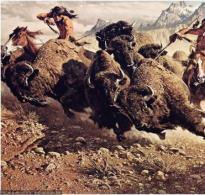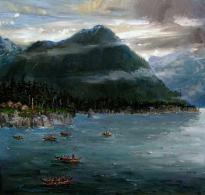What area is occupied by the plains of the Far East. Relief of the Far East. The highest mountain in the Far East. Natural wealth of the region
The territory of the Far East zonal belongs to the area of late Cenozoic folding and is part of the Pacific belt. The Russian Pacific coast is part of two converging continental plates - Asian and American. The plate contact zone is defined by the characteristic "depression" of the ocean floor.
Typical signs of oncoming plate movement and crustal activity are deep depressions and noticeable mountain building processes accompanied by earthquakes and volcanic activity. In fact, geosynclines, active zones of the earth's crust, form a contracting ring around the Pacific Ocean.
Scientists confirm the fact that the total area of the ocean is shrinking, a clear evidence of this is the so-called Pacific belt of volcanoes - a chain of high mountain ranges. The rise of the ocean floor is also characteristic of the Russian territory of the Far East. A sign of the geological youth of the region and tectonic activity is a high concentration of active and dormant volcanoes.
The Kamchatka Peninsula is known for 29 active volcanoes, while their total number in the region is about 180 units. Another evidence of activity is the Kuril Islands, built by a chain of volcanoes, in addition, a deep (9.7 km) Kuril-Kamchatsky Trench is found near the islands. Most scientists are sure that such trenches can be considered the entry point of the oceanic crust under the continental one.
The northern part of the Far East is considered to be older, having a more complex geological and tectonic structure than in the Kuril and Kamchatka zones, which are characterized by high mobility and seismological activity, which are characteristic of modern geosynclines.
Among the elements of the mainland Far East there are:
- marginal massifs;
- folding systems;
- Structured platform series.
The marginal part, located in the southeast of the region under consideration, is notable for the presence of narrow deep-water basins, which pass in the zone of the junction of the oceanic and continental crust. Geologist L.I. Red, depending on the location, highlights a group of megablocks and their constituent elements:
- Sea of Okhotsk - Koni-Taigonossky belt of volcanoes, Kuril-Kamchatka arc (islands), Sea of Okhotsk depression (southern) and massif, East-Skhalinsk and Hokaido-Sakhalinsk folded systems;
- Kolyma - Okhotsk and Omolon massifs, Okhotsk-Chukotka volcano belt, South Anyui and Verkhoyansk-Chukotka folding areas;
- Aldan-Stanovoy - Southeastern segment of the vast Siberian plate, the rising Aldan-Stanovoi shield with characteristic crystalline complexes indicating the ancient age of formation;
- Bering Sea - adjacent parts of the geosynclinal-folded Koryak system (south), the Kuril-Kamchatka arc (north) and the Aleutian-Alaska system (west);
- Amur - Sikhote-Alin volcanic belt and fold system, Khanka and Bureya massifs of intergeosynclinal type, Amur-Okhotsk fold system.
Relief of the Far East
The predominant type of relief in the Far East is mountainous, this is due to the peculiarities of the tectonic structure. The dominance of highlands determines the secondary importance of the plains and their coastal and intermountain localization. The largest plains are located within: the Central Kamchatka depression, the Anadyr and Penzhina lowlands, the Parapolsky valley.
The predominant number of ridges located in the north of the Far East are characterized as horst massifs and anticlinal uplifts. Synclinal troughs are found in depression zones. The Chukchi Ranges are composed of Verkhoyansk rocks and are of Mesozoic folding age.
In the localized region of the Okhotsk-Chukotka belt of volcanoes, ridges protruding on the northern coast of the Sea of Okhotsk, the south of the Chukotka highlands, the western part of the Anadyr-Penzhinsky depression and the ridges of the Anadyr plateau are formed. These elements have a diverse structure and are composed of structures of different ages, including Quaternary, Paleogene, and Upper Cretaceous.
They are present in the area of the structure of the Cenozoic period. The folded zone of this time includes: the Kuriles, Kamchatka, the Koryak Highlands. A characteristic feature of all the mentioned elements is their localization in a zone of high volcanic activity and a young geosyncline. The highest point of the region is located at an altitude of 4.75 km - Klyuchevskaya Sopka, the average height of the mountain peaks is 2-3 km.
In addition to tectonic processes, rivers, the ocean and climate took an active part in the formation of the region's relief. Erosion factors in the relief are traced throughout the entire Far East. Also significant factors include: physical weathering, solufication and periodic glaciations.
A characteristic and typical relief of the Far East are mid-mountain and low-mountain massifs. There is a pronounced network of deep valleys that dismember most of the massifs, and there are also a large number of mountains with flat tops. The height of the region ranges from 0.5 to 1.7 km. The most elevated zones of Kamchatka, the Koryak and Chukchi highlands have a diverse, with a predominance of alpine, relief. Most of the relief forms are glacial, and the proportion of lava plateaus is also significant.
Minerals of the Far East
The richness of the subsoil of the Russian Far East is a proven fact. The total volume of deposits makes the region a world leader in this indicator. Here lie such minerals as oil, gas, metals of various categories and classes, etc. The region can develop silver deposits, bauxites, tin, titanium and other chemical elements whose characteristics meet international standards. There are areas in the Far East, the development of which does not require large investments, all of them can be developed within a short period of time.
The process of mining in the region is difficult for the following reasons:
- Lack of exploration data;
- Lack of infrastructure;
- High transport and logistics costs;
- Small depth of occurrence of fossils.
Regardless of the complexity of the conditions, there is a noticeable increase in the role of the Far East in the economic development of the country. In the future, the region will be used to develop the latest technologies for geological exploration and mining. In general, the potential of the region is assessed as very high.
The Far East is traditionally called the territory of Russia, located off the coast of the Pacific and partially Arctic Oceans, as well as the Kuril, Commander, Shantar Islands and Sakhalin Island. The Far East is a huge territory, 36% of the total area of modern Russia.
Geography and climate
The length of the region from Chukotka to the southwest to the borders of Korea and Japan is 4500 km. It captures the Arctic Circle, where snow lies all year round. The lands in the northern part of the Far East are bound by permafrost, on which the tundra grows. In fact, almost the entire territory of the Far East, except for Primorye and the southern half of Kamchatka, is located in the permafrost zone.
To the south the climate and nature change considerably. In the south of the Far East, taiga trees coexist with plants from the subtropics (which is not repeated almost anywhere in the world).
Far East. Nature
In the view of the majority, and in fact, the Far East is a vast taiga, mountains and other irregularities of the territory that attract extreme tourists so much. The rivers Amur, Penzhin, Anadyr and a number of less significant ones flow here.
The relief of the Far East has a strongly rugged character and is represented mainly by mountainous forms. There are several watershed ranges: Kolyma, Dzhugdzhur, Yablonovyo and Stanovoy. There are powerful mountain systems, for example: the Tukuringra and Jagdy ranges. The peaks of the mountain ranges of the Far East, as a rule, do not exceed 2500 m.
The landscapes of the Far East are very diverse. Plains stretch along its tributaries. In the north and west, these plains are covered with southern taiga forests of special Daurian larch. In the south, on the flat Prikhankaysko-Amur lowland, unique Manchurian broad-leaved forests grow. Many relict and southern plants are found in them: Mongolian oak, Amur linden, white-bark elm, Manchurian ash, hornbeam, cork tree.
(function(w, d, n, s, t) ( w[n] = w[n] || ; w[n].push(function() ( Ya.Context.AdvManager.render(( blockId: "R-A -256054-1", renderTo: "yandex_rtb_R-A-256054-1", async: true )); )); t = d.getElementsByTagName("script"); s = d.createElement("script"); s .type = "text/javascript"; s.src = "//an.yandex.ru/system/context.js"; s.async = true; t.parentNode.insertBefore(s, t); ))(this , this.document, "yandexContextAsyncCallbacks");
The vast lowlands located between the mountain ranges are very interesting for their flora and fauna: Zee-Bureinskaya, Nizhne-Amurskaya, Ussuriyskaya and Prikhankayskaya. But in general, the plains occupy no more than 25% of the area of the region.
Winters are severe and with little snow, summers are relatively warm and with heavy rainfall. Winter is characterized by weak winds, a large number of sunny days, little snow and severe frosts. Especially gets from frost to the inhabitants of the most remote mainland, for example, in Transbaikalia. Here, on average, up to 10 mm of precipitation falls during the winter. Sometimes you can't go sledding either.
Rains in the Far East, the closer to China and the sea, the more similar to showers in the tropics, but only in intensity, but not in temperature. In the summer in the Far East, you can easily come across a swamp; the swampiness of the territories reaches 15-20%.
The tastiest piece of Russia for the damned imperialists. The richest region, the natural pantry of diamonds (in Yakutia more than 80% of all reserves of Russia), in almost every subject of the region there are gold deposits (50% of Russia's reserves), deposits of non-ferrous metals, minerals, there is coal, and oil, and gas.
Cities of the Russian Far East
The major cities include Vladivostok, Khabarovsk. These cities are of great economic and geostrategic importance for the country. Blagoveshchensk, Komsomolsk-on-Amur, Nakhodka, Ussuriysk, Magadan should also be mentioned.
The city of Yakutsk is of particular importance for the entire region. But in Chukotka there are endangered settlements. The places there are harsh and hard to reach - people leave.
Population of the Far East
There are many nationalities in the Far East, but Russians predominate everywhere. Russians are about 88%, the second group is Ukrainians - about 7%. There are, of course, Koreans, Chinese (which is not surprising), Belarusians, Jews.
The population of the Far East is 6.3 million people. (about 5% of the population of Russia).
Indigenous peoples:
- Yakuts,
- Dolgans, Evenki and Eveny in the north,
- the northeast is occupied by the Eskimos and Chukchi,
- on the islands - Aleuts,
- in Kamchatka - Itelmens and Koryaks,
- in the Amur basin and to the east of it - Nanai, Ulchi, terms, Orochi, Udege, Nivkhs.
The number of Yakuts is about 380 thousand people, Evenks - 24 thousand. And the rest - no more than 10 thousand people. Difficult living conditions have determined that the urban population prevails over the rural. On average, 76% of the population of the Far East lives in cities.
1) On the map, study the geographical location of this region of Russia.
Think about the impact it has on the nature of the Far East.
The Far East occupies the extreme eastern position in the country. The region stretched from Chukotka to the Ussuri region. The northern regions of the Far East lie beyond the Arctic Circle, and the southern regions lie at the latitude of the Mediterranean. The territory of the Far East consists of the mainland, peninsular (Kamchatka, Chukotka) and insular (Sakhalin, Kuril, Commander Islands, etc.). This geographical position causes a wide variety of natural conditions.
2) Determine the geographical coordinates of the extreme northern and southern points of the Far East, compare its latitudinal position with other territories of our country.
Its extreme northern point is Cape Shelaginsky (700N, 1710E), the southernmost point is at the mouth of the Tyumen-Ula River (420N, 1300E). In comparison with other regions of the country, the Far East covers a greater number of climatic zones and has a greater variety of conditions.
3) What subjects of the federation are part of this area.
It consists of six administrative units: Primorsky, Khabarovsk and Kamchatka Territories. Amur, Magadan and Sakhalin regions.
Questions in a paragraph
*Remember what resources are especially rich in the seas of the Pacific Ocean, washing the shores of Russia.
The seas of the Pacific Ocean are especially rich in biological resources, are important as international sea routes, and have great recreational potential.
*Explain why in winter there are great contrasts between the temperatures of the coastal and inland regions of the Far East.
The coastal areas have a milder and more humid monsoonal climate. Due to the features of the relief, moist air masses do not penetrate deep into the mainland, and a sharply continental climate is formed in the interior.
*Name the largest rivers flowing in the temperate zone of the Far East.
Lena, Yana, Indigirka, Kolyma.
Questions at the end of the paragraph
1. Indicate the most specific features of the geographical location of the Far East.
The extreme eastern position in the country and remoteness from other areas. The Far East has a large latitudinal elongation and a huge meridional one along the entire Pacific coast of Russia. The region has a long coastline.
2. Tell us about the explorers of the Far East, name and show the geographical objects that bear their names.
In the 17th century, Russian expansion began in Siberia and the Far East. Yakutsk was founded in 1632. In 1647, the Cossacks, led by Semyon Shelkovnikov, founded a winter hut on the shores of the Sea of Okhotsk, on the site of which Okhotsk, the first Russian port, is today. In the middle of the 17th century, Russian explorers, such as Poyarkov and Khabarov from the Yakut prison, went south to the Zeya and Amur rivers, where they encountered tribes that paid tribute to the Qing Empire (China), that is, they were under Chinese citizenship. As a result of the first Russian-Chinese conflict between Russia and the Qing Empire, the Nerchinsk Treaty was concluded, according to which the Cossacks were to transfer to the Qing government the territories of the Albazinsky Voivodeship formed on the lands of the Daurs. The treaty defined the system of trade and diplomatic relations between states. The border between the countries under the Nerchinsk Treaty in the north passed along the Gorbitsa River and the mountains of the watershed of the Amur Basin. The area of the coast of the Sea of Okhotsk between the Kivun and Taikan ranges remained undelimited. At the end of the 17th century, Russian Cossacks - Atlasov and Kozyrevsky began to explore the Kamchatka Peninsula, which at the beginning of the 18th century was included in the Russian Empire.
In 1724, Peter I sent the First Kamchatka Expedition to the peninsula, led by Vitus Bering. The expedition enriched Russian science with valuable information about the eastern coast of Siberia (in particular, the territory of today's Magadan and Kamchatka regions), new maps, accurate determinations of the coordinates of the Far Eastern coast, the strait, which was later called the Bering Strait. In 1730, the Russian government organized the Second Kamchatka expedition led by Bering and Chirikov with the task of reaching the shores of America (in particular, the Aleutian Islands and Alaska). In the 18th century, Krasheninnikov, Steller, Chichagov were engaged in the exploration of Kamchatka.
In the 18th century, Old Believers and disgraced dignitaries, such as Golovkin, were exiled to Yakutia.
In the 19th century, active development of the Far East began by Russian pioneers, which was largely facilitated by the rapid weakening of the power of the Qing empire, which in 1840 was drawn into the first opium war. The fighting against the combined forces of England and France in the south of the country, in the regions of Macau and Guangzhou, drew on significant material and human resources. The northern regions of China were left practically without any cover, which Russia did not fail to take advantage of, along with other European powers, which took an active part in the division of the decrepit Qing Empire. In 1850, Lieutenant G. I. Nevelskoy landed at the mouth of the Amur and established a military post there without permission. Convinced that the Qing administration, which by that time had not recovered from the consequences of the first opium war and was bound in its actions by the outbreak of the Taiping uprising in the country, was unable to adequately respond to the territorial claims of Russia, Nevelskoy decided to declare the mouth of the Amur and the coast of the Tatar Strait the possessions of the Russian Empire. . May 14, 1854 - the Governor-General of Eastern Siberia, Count N. N. Muravyov, having received from G. I. Nevelsky data on the absence of Qing military units along the Amur, organized the first river rafting, which included: the Argun steamer , 48 boats, 29 rafts and about 800 people. Rafting delivered to the lower reaches of the Amur ammunition, food, troops (a hundred Cossacks, the 2nd cavalry brigade of the Transbaikal army). Part of the troops then went by sea to Kamchatka to strengthen the Peter and Paul garrison, while part remained on Chinese territory to implement the Muravyov project for the development of the Amur region.
A year later, the second rafting took place, in which about 2.5 thousand people participated. By the end of 1855, there were already five Russian settlements in the lower reaches of the Amur: Irkutsk, Bogorodskoe, Novo-Mikhailovskoe, Sergeevskoe. In 1858, the right bank of the Amur officially ceded to Russia under the Aigun Treaty concluded with the Qing Empire.
3. Give a description of the relief of the Far East.
Almost the entire territory of the Far East belongs to the areas of Cenozoic folding. And in the extreme east, the earth's crust is especially unstable, and turmoil continues in our time. The relief of the Far East is mostly mountainous. This is a region of earthquakes and tsunamis, a seismic zone. In the south, medium-altitude and low mountains (Sikhote-Alin) prevail, high mountains (volcanoes) stand out on the Kamchatka Peninsula (Klyuchevskaya Sopka - 4750 m), there are territories with a flat relief (Central Kamchatka Plain - intermountain depression), there is also the Kolyma Highlands, Anadyr Plateau.
4. Why does the distribution of soils in the Far East differ from the zoning scheme of the Russian Plain?
The formation of certain soils is associated with relief and climate. Soils are tied in distribution to natural areas. The climate, relief, natural zones (their areas and distribution) of the Russian Plain and the Far East are different, and therefore the zonal distribution of soils is different.
For me, the Far East is primarily associated not with the dense forests of Eastern Siberia, but with the volcanoes of Kamchatka. In the relief of this part of Russia, clearly predominant forms can be distinguished, but even here there was a place for diversity. Moreover, I know that the region has a rather ancient geological history.
Features of the Far Eastern relief
The basis of the entire relief of the Far East is the Cenozoic folding. In its extreme northeastern part (Kamchatka), the crust has not yet settled down and the formation of folding continues, which explains the volcanic activity. Frequent guests here are:
- tsunami;
- earthquakes;
- volcanic eruptions.
In the same part of the Far East, there are the highest mountains - Klyuchevskaya Sopka, for example, 4751 m.

The southern part of the region is represented by medium and low mountains (Sikhoty-Alin), and in the middle part there are highlands (Kolyma) and plateaus (Anadyr). The transition between the mountainous part of the Far East and the plateaus is “softly” carried out by the Central Kamchatka Plain, which plays the role of an intermountain depression. Generally speaking, the region is characterized by the presence of a large number of mountain ranges, which can be both high in the north and small, in the form of hills, in the south. The mountains themselves are a clear contrast with the swampy lowlands located in the neighborhood. The relief and the large extent of the area affect the local climate, which can vary greatly in different places in the Far East: from temperate monsoon to arctic.
Volcanoes of the Russian Far East
Kamchatka and the Kuriles are the only centers of active volcanism in Russia that are part of the so-called "Ring of Fire" of the Pacific Ocean. But only in Kamchatka you can observe all types of volcanic activity.
- Highly explosive eruptions (with explosions).
- Effusive eruptions (abundant release of lava).
- Geyser (release of water vapor).
- The activity of fumaroles (rapid release of gas from cracks at the foot of volcanoes).

In total, there are 29 active volcanoes in Kamchatka, and only 5 of them pose a danger to humans.
The Far East consists of 8 regions. These regions have many differences: climate, geological structure, etc. All these features are largely influenced by the relief of the Far East. The largest subjects: Yakutia, Primorye, Khabarovsk Territory, Kamchatka, Chukotka and Sakhalin. Smaller in area are the Amur Region and the Jewish Autonomous Region.
In geography, there is such a thing as a physical-geographical country. This is a large unit of measure for the terrain. It means any part of the mainland where the relief is the same or logically passes from one to another. A geographic country includes more territories than a geographic area.
Let's study in more detail the geological structure and relief of the Far East.
Northeast Siberia
One of the geographical countries is North-Eastern Siberia. The borders of this zone included Yakutia, Chukotka and the Magadan region. North-Eastern Siberia in the north is washed by the East Siberian and Chukchi. To the south is the Sea of Okhotsk. This is the largest part that determines the landforms of the Far East.
Northeastern Siberia is characterized by the fact that the highest mountains of this region form a kind of arc, similar to an amphitheater. It includes the Kolyma Highlands and the Verkhoyansk Range. These are the highest mountain peaks stretching along the eastern and southern parts of North-Eastern Siberia. The Kolyma Highlands is mostly located on the territory of the Magadan Region. There are many useful resources hidden in the Kolyma Highlands. These places are rich in deposits of gold and tin, and in addition, in these parts there are various thermal springs.
The Suntar-Khayata Ridge: a brief description
The Suntar-Khayat ridge is one of the important components that make up the relief. It is also part of the resulting "amphitheater". This mountain range stretches for a distance of up to 450 kilometers, and its highest point is determined by a mark of 2959 meters. Over 200 sq. km of Suntar-Khayat is occupied by glaciers, and another 800 sq. km. km was occupied by perennial icing formed by groundwater. Its thickness in some places can reach 8 m.

Northeast Siberia: Verkhoyansk Ridge
The longest mountain range in North-Eastern Siberia is the Verkhoyansk Range. The characteristics of the relief of the Far East will be incomplete if we do not consider in more detail these peaks. The Verkhoyansk Range stretches for 1200 km in length. Its width in some places reaches 250 km. The mountain peaks of this range rise 2 km above sea level. The Verkhoyansk mountain range belongs to the territory of Yakutia.

Chersky Ridge
A little lower from the Verkhoyansk ridge settled in a large number of plateaus. They include and its highest point is located on Mount Pobeda, which reaches a height of 3003 meters above sea level. The Chersky Ridge stretches for one and a half thousand kilometers, capturing the territory of the Magadan Region and Yakutia.

Northeast Siberia: lowlands
The features of the relief of the Far East are presented not only in mountain formations, but also in the lowlands. There are two last ones in North-Eastern Siberia. These are Kolyma and Yano-Indigirskaya. Together they form the swampy East Siberian Lowland, which is the lowest level of the relief of this region. Its average height ranges from 50 to 100 meters above sea level. The climate in these places is subarctic, and the entire territory of North-Eastern Siberia is divided into tundra, taiga and the zone of arctic deserts.
Primorsky Krai
The relief of the Far East in the Primorsky Territory consists of 20% lowland, which is located in the territory south of Lake Khanka. It is believed that this place is the most populated not only in the Primorsky Territory, but also in the entire Far East. The Khanka Plain is surrounded by the Sikhote-Alin and Manchurian mountains. The climate here, as elsewhere in Primorye, is temperate monsoon. The most full-flowing river in Primorsky Krai is the Ussuri, which begins its course from the slopes of Snezhnaya Mountain. The highest point is Anik Peak, located at an altitude of 1933 meters.
Features of the Sakhalin Territory
The relief of the Far East on Sakhalin is mainly represented by mountain formations of medium height. And in the north of the island, hilly plains prevail. There are as many as 11 selected relief areas on Sakhalin. The Schmidt Peninsula is characterized by steep steep coasts in the north and mountain ranges up to 623 meters high. To the south, the mountainous relief of the peninsula passes into the North Sakhalin Plain. Its highest point is 601 m. The northeastern coast of Sakhalin, distinguished as a sub-region, boasts large lagoons. The West Sakhalin Mountains stretch along the western coast of the island. Their length is 630 km. They stretched almost to the extreme south of the island.
In the middle part of Sakhalin, the Tym-Poronai lowland is located, so named due to the Tym and Poronai rivers, along which it was formed. The Susunai lowland rests against the West Sakhalin Mountains. It is located in the south of the island and has a length of about 100 km from north to south.
The East of Sakhalin is framed by the East Sakhalin Mountains. This region includes the Nabilsky mountain range, which passes into the Central and then abruptly turns into the North Sakhalin lowland. The city of Korsakov is located on the Korsakov plateau. The plateau has a wavy surface, which is formed by small flat-topped ridges. The climate on Sakhalin is dominated by temperate monsoon.

Kamchatka: relief and features
The relief of the Far East (Kamchatka) is mainly composed of the two largest - East and Middle. Mountains occupy two thirds of the territory of the Kamchatka Territory. Seismic activity is highly developed in these places, frequent earthquakes occur. This is due to the fact that Kamchatka continues to rise. Some areas of land that were relatively recently under water have now risen and continue their upward movement.
The strongest earthquakes, the power of which reached 8 points, were registered in the eastern part of the peninsula. Towards the center, the strength of earthquakes decreases to 6 points, and the weakest shaking occurs on the west coast. There they are rated 5 points or less. Some volcanoes continue to operate in Kamchatka. One of them is called its height now 4750 meters. The largest number of volcanoes is concentrated in the Sredinny Ridge. Some of them collapsed due to constant eruptions. They were so strong that practically no traces of the ancient volcanoes remained. Their existence today can be known only by the characteristic breed. Kamchatka also abounds in ore deposits, placers of non-ferrous metals and fossil fuels. There are about 600 tons of gold reserves in the lands of this region.

Summing up
According to all the data, it can be judged that the relief of the Russian Far East is characterized by a large number of mountain ranges. Moreover, both high (in the center of the district) and small hills, which are closer to the extreme northern and southern points. Mountains contrast with deep swampy plains that stretch along rivers and lakes. But the climate, due to the large length of the district, is very different. Moderate monsoon in south to arctic in north. Also in the Far East, almost all activities for the extraction of diamonds and tin are concentrated.





